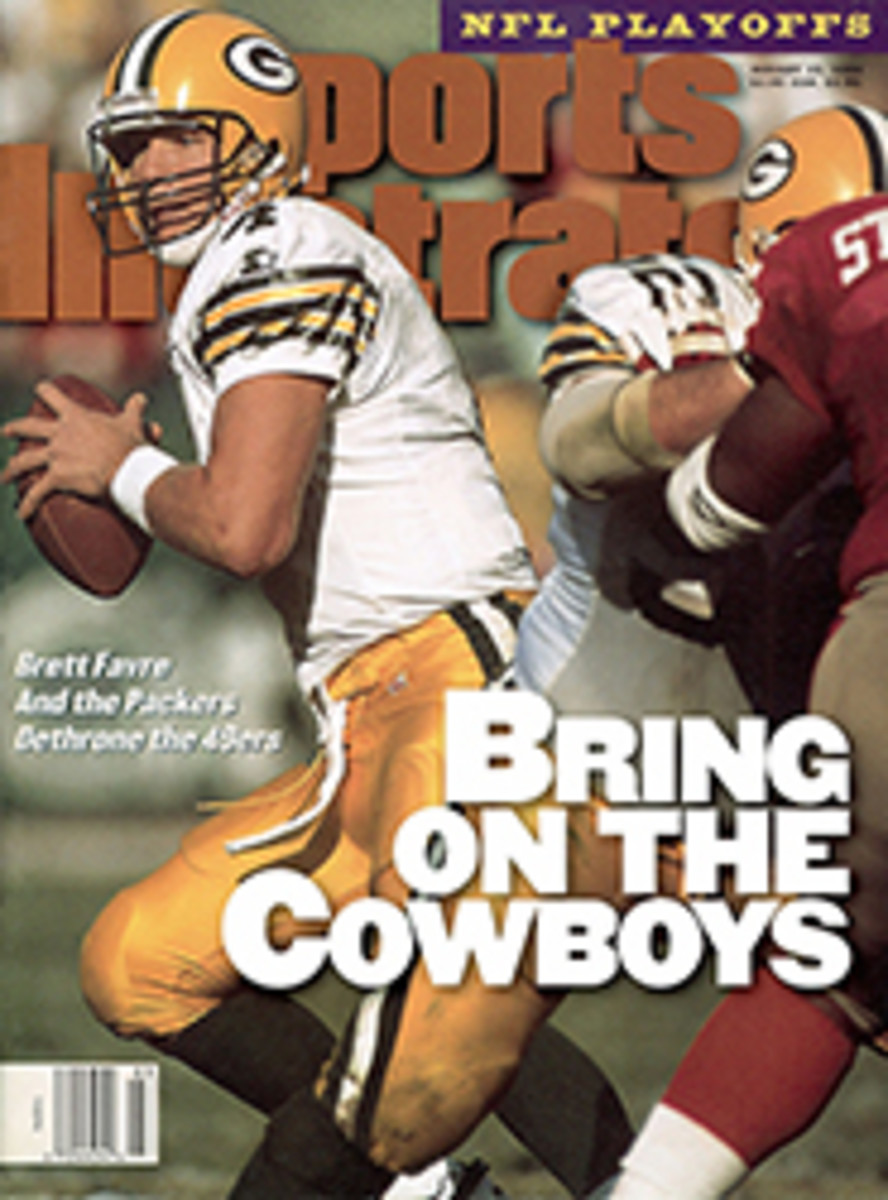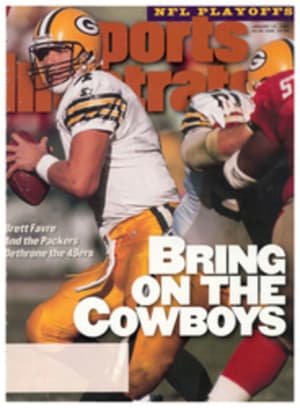
HEADED FOR A FALL? NEBRASKA MAY WIN ANOTHER NATIONAL TITLE, BUT THE DAYS WHEN SUCH A COLOSSUS RULED THE GAME ARE OVER
It was tempting enough to become enthralled with Nebraska's
brilliance in its 62-24 Fiesta Bowl humiliation of Florida on
Jan. 2. It was impossible not to marvel at the performances of
senior quarterback Tommie Frazier, junior I-back Lawrence
Phillips and the Cornhuskers' swift, lethal pass rush. Even
though Florida was a very good team, it left Tempe, Ariz., in
little pieces.
In winning its second consecutive national championship,
Nebraska was transcendent that night in the desert--and you're
not going to see the likes of that team again. All season the
Huskers trampled the opposition like a colossus, but in the fall
the supremely talented Frazier, along with 10 other senior
starters, will be gone, Phillips will probably be in the NFL,
and Nebraska's unique talent base will have been eroded by the
rules of the new Big 12--the Big Eight plus Baylor, Texas, Texas
A&M and Texas Tech--which begins play in 1996.
Sure, Nebraska will always be one of the most powerful programs
in college football--along with teams like Florida State,
Michigan and Notre Dame--but beginning next fall the Cornhuskers
will be part of the pack, fighting with Florida (again),
Tennessee, Michigan, Syracuse, Miami and, who knows, maybe even
Kansas State, for a national title.
That is why Nebraska coach Tom Osborne, still soaked and
shivering from the obligatory ice-water dousing by his players,
used his Fiesta Bowl postgame press conference to grumble, in
NCAA-speak, about preserving his program's might. He launched
into a plea to the presidents of the Big 12 to reconsider their
recent decision to limit the recruitment of student-athletes who
were once known as Prop 48s.
We already knew that Osborne was not much of a celebrator. But
his timing on this issue seemed awkward and inappropriate. His
team had just become the first in 39 years to win back-to-back
consensus national titles. The Cornhuskers had fallen three
points short of winning three consecutive national titles (they
lost the 1994 Orange Bowl to Florida State 18-16), which has
never been done. The morning after the Fiesta Bowl, Osborne did
call the 1995 Huskers his best team, yet rather than bask in
their accomplishment, he steered a captive audience to an arcane
topic. It was something he had done frequently in the days and
weeks leading to the game, fearing his giant program would soon
be diminished.
That the Cornhuskers have been so dominant during a period in
which NCAA-mandated football downsizing has tended to create
parity is remarkable. The limit of 85 football scholarships per
school (down from 95 in 1991 and 105 in '76), in conjunction
with the raising of admission standards and the tightening of
recruiting rules, has helped programs such as Kansas State,
Oregon, Virginia Tech and, most famously, Northwestern, rise to
prominence.
Nebraska has flourished as a superpower during that time because
the Cornhusker program benefits from the convergence of many
supporting structures. The Huskers have a smart, stubborn coach
with 23 years of experience; unshakable faith in a football
system built on the option and the running game and brutal,
fast-paced practices; and facilities that include a
30,000-square-foot weight room, which is advertised as the
largest among NCAA schools. The only major public university in
the state, Nebraska has virtually an open admissions policy and
low tuition (less than $3,000 for in-state students), which
brings in walk-ons by the dozen. (Nebraska had 141 players on
its Fiesta Bowl roster, a number reminiscent of Bear Bryant's
days at Alabama but unusual in 1996. By contrast, Florida had
94.) Nebraska also willingly accepts athletes who represent
academic and/or social risks. Finally, there comes an occasional
gift, a once-in-a-generation talent like Frazier, who arrived in
Lincoln from Bradenton, Fla., in 1992.
"It's a machine up there," says Colorado coach Rick Neuheisel
admiringly. "I know because I've got to beat them."
Still, Osborne dourly stumps. And with good reason. The loss of
Frazier, the team's undisputed leader, is almost
immeasurable--"Half an offense, by himself," said Colorado State
coach Sonny Lubick. Without Frazier, Nebraska wouldn't have been
competitive in its loss to No. 1-ranked Florida State in the '94
Orange Bowl; the Huskers probably wouldn't have beaten Miami in
the '95 Orange Bowl to win the national title; and there
wouldn't have been talk of a dynasty coming out of the Fiesta
Bowl. And for those who thought that Cornhusker freshman I-back
Ahman Green was as good as Phillips, the Fiesta Bowl should have
proved that Green is good, but Phillips, who rushed for 165
yards and scored three touchdowns against Florida, is exceptional.
Still, what most threatens Nebraska's championship streak is the
Big 12's policy on accepting partial and non-qualifiers under
NCAA freshman eligibility guidelines. (A partial qualifier is a
prospective athlete who meets only one of two minimum academic
requirements--grade point average or standardized test score. The
minimums are a 2.0 GPA with a 900 on the SAT or 21 on the ACT;
or a 2.5 GPA with a 700 SAT or 17 ACT. A non-qualifier meets
neither standard. If a school accepts a partial or
non-qualifier, the athlete is ineligible for athletics for one
year). On Dec. 20 the Big 12 presidents voted unanimously to
limit each school to four partial qualifiers per year (two men,
two women) and no more than one in a single sport.
Non-qualifiers were excluded entirely.
In the Fiesta Bowl, Nebraska started four partial or
non-qualifiers (cornerback Michael Booker, defensive tackle
Christian Peter, cornerback Tyrone Williams and defensive end
Jared Tomich), and two others, wideout Reggie Baul and outside
linebacker Jamel Williams, played almost as much as the
starters. According to Nebraska officials there were at least 12
partial or non-qualifiers in the program last fall. "Among elite
schools Nebraska is a true haven for partial and
non-qualifiers," said the coach of another elite school.
Osborne's view on partial and non-qualifiers--he calls them
"Props," harking back to Proposition 48, which created the
aforementioned eligibility guidelines that affected incoming
freshmen in 1986--is similar to his reasoning for reinstating
Phillips, who was suspended from the team after he was arrested
for assaulting his former girlfriend on Sept. 11. (Phillips
eventually pleaded no contest and was restored to the team on
Oct. 24.) In both cases, the argument goes, kids were given
academic opportunities they might not otherwise have found. And
Nebraska landed impact players.
"I hope [the Big 12 presidents] will take a look at the fact
that the Big Eight has four teams in the top 10 [Nebraska, No. 5
Colorado, No. 7 Kansas State and No. 9 Kansas]," said Osborne,
after the Fiesta Bowl. "We did it with Big Eight rules."
(Actually, the Big Eight has no policy on partial and
non-qualifiers.) If the Big 12 does not amend its rules, Osborne
could threaten to pull Nebraska out of the conference. But it is
unlikely that the Big East, Big Ten or Pac-10, the other major
conferences that have no policy on partial and non-qualifiers,
would welcome Nebraska because of its modest academic standards
or remote location.
Prop 48--which is scheduled to be replaced by Prop 16 this
summer--is still one of the hot-button issues in college sports:
Who deserves an athletic scholarship? But in Nebraska's case,
consider this: Two of the four partial or non-qualifiers who
started in the Fiesta Bowl (Tyrone Williams and Peter) were
among the five Cornhuskers charged with crimes in the last 22
months. Yet, if there have been occasional problems with partial
and non-qualifiers at Nebraska, there has also been a
significant athletic benefit. Both Williamses, Booker and 1994
cornerback Barron Miles (also a partial qualifier) were among
the players who upgraded Nebraska's defense from the plodding
bunch that couldn't keep up with Miami and Florida State in the
late 1980s and early '90s to the swift, attacking unit that
crushed Florida.
Osborne is no fool. Nebraska's hold on greatness is tenuous;
that large gap between the Cornhuskers and everybody else could
close quickly. Take away Frazier, Phillips and the partial and
non-qualifiers, and Nebraska's 12-0 record this season could
have been 10-2, which might have put the Huskers in a
meaningless Cotton Bowl matchup instead of in a showdown for the
national championship.
Osborne's staff is trying desperately to sign a quarterback who
will be able to start next year as a freshman, just as Frazier
did in '92. But a find like Frazier is rare, so there's a good
chance that next year's Sugar Bowl, the site of the national
championship game, will be played without Nebraska.
Florida will challenge for the national title again. Don't
laugh. Think of the Gators as the football parallel to Duke's
1990 basketball team, which was drilled 103-73 by UNLV in the
NCAA championship game and then came back the next year to beat
the Runnin' Rebels en route to the first of its back-to-back
titles. Gator quarterback Danny Wuerffel returns, along with two
of his top three receivers and five other offensive starters.
Yet for Florida to reach the title game--the Southeastern
Conference title game--it will again have to dispose of Tennessee
and its quarterback, Peyton Manning, whose poise and maturity
only make him seem as if he's 30 years old and an NFL veteran.
And Florida will travel to Knoxville this fall.
Or perhaps the national champion will come out of the Big East,
where Syracuse quarterback Donovan McNabb might have the impact
on his team that Frazier had on the Huskers, and where Miami has
found a new quarterback in Ryan Clement and retains several
experienced starters on both sides of the ball.
Assuming Michigan running back Tshimanga Biakabutuka doesn't go
to the NFL and quarterback Scott Dreisbach recovers from the
injured thumb on his right hand, the Wolverines will be the Big
Ten favorite. Kansas State's nonleague schedule is again
laughably soft, and next season Nebraska must travel to
Manhattan, Kans., to play the Wildcats.
The field is open again. Keep your '96 Fiesta Bowl videotapes in
a safe place, because you won't see dominance like that again.
There are no more Nebraskas. Not even in Nebraska.
COLOR PHOTO: RICHARD MACKSON If Phillips (1) departs for the NFL, that will hasten the Cornhuskers' return to the pack next fall. [Lawrence Phillips carrying football against University of Florida]COLOR PHOTO: DOUG PENSINGER Syracuse, Kansas State and Tennessee, led by McNabb (5), Eric Hickson (24), and Manning, respectively, are early favorites to end the Husker run. [Donovan McNabb]
COLOR PHOTO: RICHARD MACKSON [See caption above--Eric Hickson]
COLOR PHOTO: PATRICK MURPHY-RACEY [See caption above--Peyton Manning]

